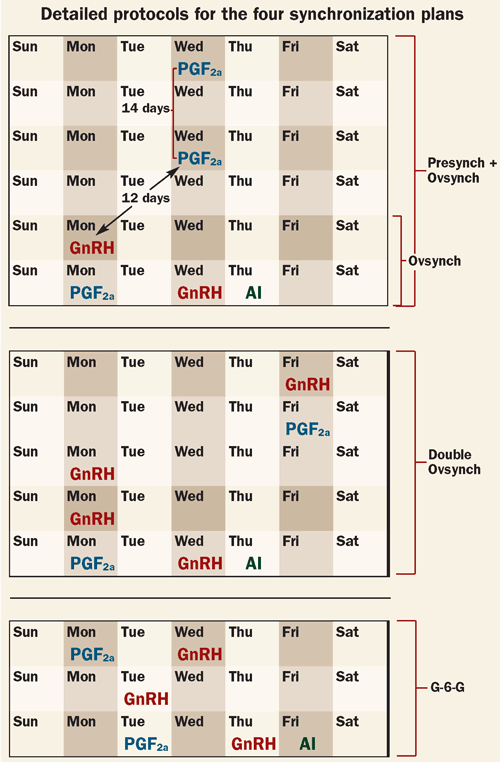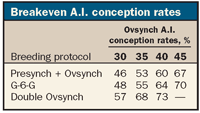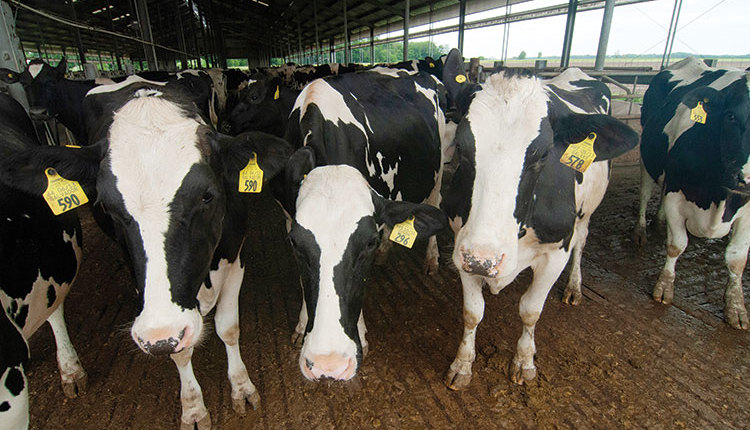The author is professor of animal sciences at Kansas State University, Manhattan.
There are so many synchronization programs that can be used on my dairy herd. My question for a future Artificial Breeding column is which synchronization program would result in the highest conception rates of cows? C.R., New York
Dairy producers are like other good business people. They are looking for solutions to the problems of the day. The real challenge is that a solution that may be ideal for one dairy may not be the best for another. We often receive inquiries about which timed A.I. program will result in the best conception rates. Well, the answer to that question is (drum roll) . . . it depends!
Let me try and tackle that question by presenting a summary of the scientific evidence we have available where head-to-head comparisons of timed A.I. programs have occurred in the same herd(s). Let's examine the four most popular programs.

Nearly all published information has shown that Presynch + Ovsynch produced better A.I. conception rates than using Ovsynch alone. This has been true when either 11, 12, or 14 days elapsed between the second Presynch injection and the onset of Ovsynch. The gain is about 10 to 15 percentage points.
Adding a CIDR to the Ovsynch protocol and comparing that to Ovsynch has not consistently improved A.I. conception rates. Given the cost of the CIDR ($9 to $10 each), justification of its use in all cows as part of an ovulation control program before first service is not warranted by the results. But that's not the entire story.
In contrast, when cows were inseminated based on standing heat after either the first or second Presynch injection, and the remaining cows were then treated with the Ovsynch protocol (with or without a CIDR), better A.I. conception rates were reported in those cows receiving the CIDR. The gain was about 5 percentage points.

Cows treated with G-6-G were compared to the standard Ovsynch protocol. With limited numbers of cows, G-6-G produced more pregnancies than Ovsynch alone. The increase was about 10 percentage points.
So, ranking the protocols in terms of A.I. conception rates, Double Ovsynch is likely somewhat better than Presynch + Ovsynch and G-6-G, and all of these prebreeding programs probably exceed Ovsynch alone. The CIDR + Ovsynch may provide a small advantage in A.I. conception rates if applied to cows that have not yet been inseminated for the first time after one or two prostaglandin injections.
Consider cost factors
Costs of these protocols vary. Let's work with the following costs: GnRH is $3.20 per dose; prostaglandin is $2.50; and the cost per cow handling is $1.
The break-even cost for different protocols is compared with that of Ovsynch (least expensive timed A.I. program) in the table. You can see that programs other than Ovsynch which are more expensive must get better results or they are not paying their way. For example, it costs nearly twice as much per cow to apply Double Ovsynch, so the number of conceptions must nearly double to cover the program costs. When a CIDR is added to any program, another $9 to $10 is added per treated cow. These cost factors are important to consider.
Compliance a must
Anytime you add another cow handling to a program, you are likely raising the probability that not every cow will be treated with the right product at the right time.
Just consider the Ovsynch program where cows are handled four times. If the probability of correctly treating a cow (finding and injecting her with the appropriate product on the correct day) is 95 percent, then the probability that all cows are handled correctly at each of four handlings is only 81.4 percent (0.95 x 0.95 x 0.95 x 0.95). In other words, compliance was 81 percent. Poor compliance reduces timed A.I. conception rates. If cows were handled seven times as with the Double Ovsynch program with the same accuracy, compliance would be 70 percent.
Consider all factors before making a change in your timed A.I. program. Keeping things simple and understandable for everyone involved in the breeding program is priority one. Knowing the difference between products to be used, using proper syringe and needle sizes (18-g, 1.5-inch), and following instructions are key to a high rate of compliance and good AI conception rates.
Click here to return to the Reproduction E-Sources
100410_276
There are so many synchronization programs that can be used on my dairy herd. My question for a future Artificial Breeding column is which synchronization program would result in the highest conception rates of cows? C.R., New York
Dairy producers are like other good business people. They are looking for solutions to the problems of the day. The real challenge is that a solution that may be ideal for one dairy may not be the best for another. We often receive inquiries about which timed A.I. program will result in the best conception rates. Well, the answer to that question is (drum roll) . . . it depends!
Let me try and tackle that question by presenting a summary of the scientific evidence we have available where head-to-head comparisons of timed A.I. programs have occurred in the same herd(s). Let's examine the four most popular programs.
The programs
- Ovsynch - One GnRH injection (2 cc of Cystorelin, Factrel, Fertagyl, or OvaCyst) seven days before prostaglandin F2a (2 cc of Estrumate or estroPLAN or 5 cc of Lutalyse, Prostamate, or In-Sync); a second GnRH injection 48 to 56 hours after prostaglandin; and then timed A.I. 12 to 18 hours later. A variation of this protocol is adding a progesterone-releasing intravaginal controlled internal drug release (CIDR) insert beginning with the first GnRH injection and its removal when prostaglandin is injected seven days later.
- Presynch + Ovsynch - two injections of prostaglandin are administered 14 days apart with the second injection given 10 to 14 days before starting Ovsynch.
- Double Ovsynch - A full prebreeding Ovsynch protocol is applied without A.I. The second GnRH injection of the prebreeding Ovsynch is administered seven days before initiating the breeding Ovsynch.
- G-6-G - A prostaglandin injection is given two days before a GnRH injection. Six days after GnRH, the breeding Ovsynch is initiated.

Nearly all published information has shown that Presynch + Ovsynch produced better A.I. conception rates than using Ovsynch alone. This has been true when either 11, 12, or 14 days elapsed between the second Presynch injection and the onset of Ovsynch. The gain is about 10 to 15 percentage points.
Adding a CIDR to the Ovsynch protocol and comparing that to Ovsynch has not consistently improved A.I. conception rates. Given the cost of the CIDR ($9 to $10 each), justification of its use in all cows as part of an ovulation control program before first service is not warranted by the results. But that's not the entire story.
In contrast, when cows were inseminated based on standing heat after either the first or second Presynch injection, and the remaining cows were then treated with the Ovsynch protocol (with or without a CIDR), better A.I. conception rates were reported in those cows receiving the CIDR. The gain was about 5 percentage points.

Cows treated with G-6-G were compared to the standard Ovsynch protocol. With limited numbers of cows, G-6-G produced more pregnancies than Ovsynch alone. The increase was about 10 percentage points.
So, ranking the protocols in terms of A.I. conception rates, Double Ovsynch is likely somewhat better than Presynch + Ovsynch and G-6-G, and all of these prebreeding programs probably exceed Ovsynch alone. The CIDR + Ovsynch may provide a small advantage in A.I. conception rates if applied to cows that have not yet been inseminated for the first time after one or two prostaglandin injections.
Consider cost factors
Costs of these protocols vary. Let's work with the following costs: GnRH is $3.20 per dose; prostaglandin is $2.50; and the cost per cow handling is $1.
- Then the cost (excluding semen) of applying Ovsynch is $12.90 per cow (four cow handlings)
- The cost of Presynch + Ovsynch is $19.90 per cow (six cow handlings); that of G-6-G is $20.60 (six cow handlings)
- Double Ovsynch is $24.80 (seven cow handlings).
The break-even cost for different protocols is compared with that of Ovsynch (least expensive timed A.I. program) in the table. You can see that programs other than Ovsynch which are more expensive must get better results or they are not paying their way. For example, it costs nearly twice as much per cow to apply Double Ovsynch, so the number of conceptions must nearly double to cover the program costs. When a CIDR is added to any program, another $9 to $10 is added per treated cow. These cost factors are important to consider.
Compliance a must
Anytime you add another cow handling to a program, you are likely raising the probability that not every cow will be treated with the right product at the right time.
Just consider the Ovsynch program where cows are handled four times. If the probability of correctly treating a cow (finding and injecting her with the appropriate product on the correct day) is 95 percent, then the probability that all cows are handled correctly at each of four handlings is only 81.4 percent (0.95 x 0.95 x 0.95 x 0.95). In other words, compliance was 81 percent. Poor compliance reduces timed A.I. conception rates. If cows were handled seven times as with the Double Ovsynch program with the same accuracy, compliance would be 70 percent.
Consider all factors before making a change in your timed A.I. program. Keeping things simple and understandable for everyone involved in the breeding program is priority one. Knowing the difference between products to be used, using proper syringe and needle sizes (18-g, 1.5-inch), and following instructions are key to a high rate of compliance and good AI conception rates.
100410_276










